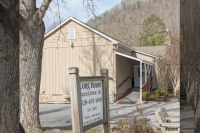Golf course on the rocks
An ongoing lawsuit against the owners of Smoky Mountain Golf Course alleges numerous problems with the course’s management under its out-of-state owners.
The 133-acre, 18-hole golf course in Whittier is owned by a group from Pennsylvania under the corporate entity Woodville Associates. The suit was filed three years ago by the owner of Smoky Mountain Country Club, Mike Cornblum, alleging a breach of contract against the golf course owners.
According to a 1998 agreement, Woodville was supposed to keep the golf course “well maintained and in a good state of repair.”
In the lawsuit, Cornblum claims Woodville failed to do so. Chief among the complaints are the subpar golf cart paths.
“The cart paths are dangerous due to both the severe downward slope of the cart paths and the cart paths are crumbling in many areas,” the suit alleges.
Related Items
The suit claims that tee-boxes, sand traps and fairway grass were not maintained. Poor drainage resulted in standing water in both sand traps and fairways, creating “eyesores.” The driving range was “unsightly” due to lack of maintenance. Half the golf carts were not functioning. The pro-shop needed fixing up, including a broken sliding door that served as the entrance. Even the maintenance shed was a source of contention.
“Old and broken equipment scattered around it create a visual eyesore — looks like the junkyard that it is,” the suit states.
The 1998 agreement also required Woodville to make improvements in the course to make it “reasonably playable” by average golfers. Several holes were redesigned, but Cornblum alleged holes 5 and 16 are still in need of a new layout.
“The 5th hole requires a forced carry of the golf ball on the shot from the mountain top to the valley floor, and this shot is not achievable by many golfers,” according to Cornblum’s suit. “The tee shot on the 16th hole is a blind shot to an inadequately small landing area that is sloped to cause the golf balls to roll off the fairway resulting in lost balls. The second shot, also a blind shot, requires a forced carry of the golf ball on the shot from the fairway across a deep ravine to the green, and this shot is not achievable by many golfers.”
In late 2004 — a year after the initial lawsuit was filed — the two parties sat down for a court-ordered mediation. Woodville decided to sell the golf course, but in the meantime, it agreed to make basic repairs of the more neglected areas. Woodville agreed to pave crumbling sections of golf cart paths, repair a dozen or so sand traps, fix drainage issues on the fairways and keep the course maintained.
Woodville had 60 days to comply. Instead, it let the deadline slip by and asked the court for an extension until spring 2005. That deadline came and went also without Woodville doing the work. Cornblum appealed to the court.
“To this date, Woodville has not performed any of the work it agreed to do,” Cornblum claimed in a July 2005 court filing. “Woodville has failed to fulfill the terms of the maintenance and repair agreement and there is no reason for delay in completing this work.”
The court ordered Woodville to deposit $75,000 in an escrow account so the golf course superintendent, Jeremy Boone, could carry out the basic repairs.
The repairs were intended to tide the course over until Woodville sold it to new owners. But there was little movement toward a sale.
In a second round of mediation in fall of 2005, Cornblum offered to buy the course from Woodville. Woodville agreed. Judge James Downs signed the agreement, making the sale of the golf course from Woodville to Cornblum a court order.
It was up to Judge Downs to orchestrate the sale given the hostile atmosphere between the parties. The first obstacle was agreeing on a price tag. It proved to be a stumbling block that would hold up the sale for another two years.
Downs wanted three appraisers to weigh in on the market value of the course. To pick the appraisers, Downs had each party to submit two names to the court. Downs selected one appraiser from each list. Those two appraisers in turn selected a third. The average of the three appraisals would be the selling price. The parties put $10,000 in a court-held escrow to pay the three appraisers.
The appraisal got off to a rocky start. Cornblum and Woodville had different ideas of what market value meant. Woodville wanted the property appraised irrespective of its status as a golf course. The land would fetch a higher asking price if sold for a development other than as a golf course.
But under the 1998 agreement, the property had to remain a golf course at least through the year 2014. It was preposterous to appraise the golf course as anything but a golf course, since the buyer would be obligated to maintain it as such, argued Cornblum.
The conflict nearly derailed the deal. The impasse landed Woodville and Cornblum back in court for Judge Downs to sort out. Downs said the golf course should be appraised as a golf course, since that’s all it could be used for under the 1998 agreement.
By now, several more months had passed, and it would be May 2006 before the appraisal was finished. But factors thwarting the golf course sale had hardly been put to rest.









